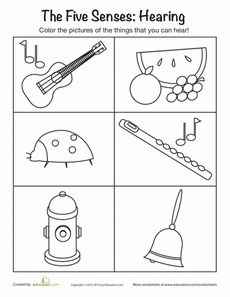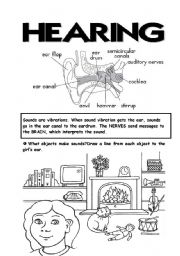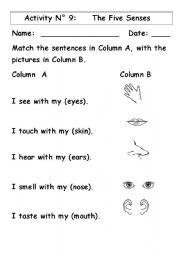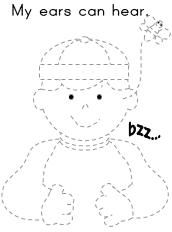Sense of Hearing Activity Worksheets
The Sense of Hearing Activity Worksheets provide an engaging way for students to explore and learn about the fascinating entity of sound and the subject of hearing. These worksheets are designed to cultivate a deeper understanding of how our ears and brain work together to perceive sounds and their characteristics. With a variety of exercises and puzzles, these worksheets are perfect for educators or parents looking to enhance their elementary or middle school science curriculum with hands-on learning experiences.
Table of Images 👆
More Other Worksheets
Kindergarten Worksheet My RoomSpanish Verb Worksheets
Cooking Vocabulary Worksheet
DNA Code Worksheet
Meiosis Worksheet Answer Key
Art Handouts and Worksheets
7 Elements of Art Worksheets
All Amendment Worksheet
Symmetry Art Worksheets
Daily Meal Planning Worksheet
What are the main parts of the ear?
The main parts of the ear are the outer ear, middle ear, and inner ear. The outer ear consists of the pinna (auricle) and the ear canal, which collect and direct sound waves towards the eardrum. The middle ear includes the eardrum and three tiny bones called the ossicles (malleus, incus, and stapes) that transmit sound vibrations to the inner ear. The inner ear contains the cochlea, semicircular canals, and vestibule, which are responsible for converting sound waves into electrical impulses that are sent to the brain for interpretation.
How does sound travel through the ear?
Sound waves are collected by the outer ear and channeled into the ear canal, where they hit the eardrum causing it to vibrate. These vibrations are then transmitted through the three small bones in the middle ear - the hammer, anvil, and stirrup - which amplify the sound and transfer it to the fluid-filled cochlea in the inner ear. The movement of the fluid in the cochlea stimulates hair cells that convert the vibrations into electrical signals, which are sent to the brain via the auditory nerve, allowing us to interpret and perceive sound.
What is the role of the cochlea?
The cochlea is an important part of the inner ear that is responsible for converting sound waves into electrical signals that can be interpreted by the brain. It is shaped like a snail shell and contains hair cells that vibrate in response to different frequencies of sound. These vibrations are then transmitted to the auditory nerve, which carries the signals to the brain where they are processed and interpreted as sound.
How do hair cells help with hearing?
Hair cells in the inner ear play a crucial role in hearing by converting sound waves into electrical signals that are transmitted to the brain. These specialized cells are responsible for detecting sound vibrations and translating them into neural impulses that the brain can interpret as sound. Hair cells are organized in the cochlea of the inner ear and are essential for our sense of hearing.
What is the difference between high-frequency and low-frequency sounds?
High-frequency sounds have a shorter wavelength and are characterized by a higher pitch, while low-frequency sounds have a longer wavelength and are associated with a deeper pitch. High-frequency sounds are more easily absorbed and attenuated by obstacles in the environment, while low-frequency sounds are harder to obstruct and can travel further distances. Additionally, high-frequency sounds are typically perceived as more directional and localized, while low-frequency sounds are more omnidirectional and can be felt more than heard.
How do we determine the direction of a sound?
The direction of a sound is determined by the arrival time and intensity of the sound waves at our ears. Our brain processes the differences in timing and volume between the sound reaching each ear, allowing us to localize the source of the sound in space. This process is known as binaural hearing and helps us to perceive the direction and distance of sounds in our environment.
What is the purpose of the eardrum?
The eardrum, also known as the tympanic membrane, serves the important purpose of vibrating in response to sound waves that enter the ear canal. These vibrations transmit the sound to the middle and inner ear, where it is converted into nerve impulses that can be interpreted by the brain as sound. The eardrum acts as a crucial barrier that protects the delicate middle and inner ear structures while also helping to amplify and transmit sound signals effectively.
How does our brain process sound signals?
When sound waves enter our ears, they are captured by the outer ear and funneled into the ear canal, reaching the eardrum. The eardrum vibrates in response to the sound waves, which then travel through three small bones in the middle ear called the ossicles. These bones amplify the vibrations and transmit them to the cochlea in the inner ear, where they are converted into electrical signals by thousands of hair cells. These electrical signals are then sent through the auditory nerve to the brainstem and eventually to the auditory cortex in the brain where they are interpreted as sound.
What are some common hearing problems?
Some common hearing problems include age-related hearing loss (presbycusis), noise-induced hearing loss, tinnitus (ringing in the ears), ear infections, Meniere's disease (a disorder of the inner ear that affects balance and hearing), and otosclerosis (abnormal bone growth in the middle ear). It's important to consult a healthcare professional if you experience any changes in your hearing to determine the cause and appropriate treatment.
How can we protect our sense of hearing?
To protect our sense of hearing, we can take measures such as wearing ear protection in loud environments like concerts and construction sites, turning down the volume on personal audio devices, taking regular breaks from noise exposure, avoiding prolonged exposure to loud noises, and getting regular hearing screenings to monitor any changes in our hearing health. It's also important to educate ourselves and others on the risks of noise-induced hearing loss and take steps to prioritize our hearing health in our daily lives.
Have something to share?
Who is Worksheeto?
At Worksheeto, we are committed to delivering an extensive and varied portfolio of superior quality worksheets, designed to address the educational demands of students, educators, and parents.
























Comments